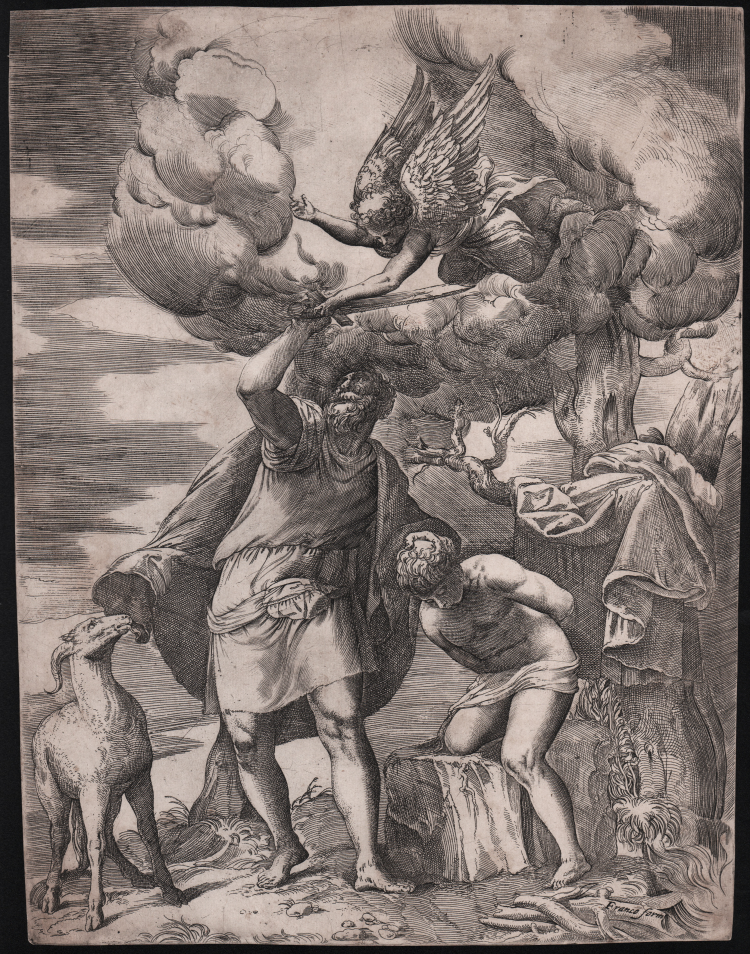




| Reference: | S44350 |
| Author | Giovanni Battista FRANCO |
| Year: | 1550 ca. |
| Measures: | 260 x 341 mm |



| Reference: | S44350 |
| Author | Giovanni Battista FRANCO |
| Year: | 1550 ca. |
| Measures: | 260 x 341 mm |
The sacrifice of Abraham who raises his arm to slay Isaac but is stopped by the angel above, to the left is a ram
Engraving and etching, circa 1550, lettered at bottom right 'Franco form'.
This is the second state with the addition of Franco's name.
Giovanni Battista Franco, known as Battista Franco Veneziano, but sometimes called the Semolei, or simply Battista Franco. He was a typographer, engraver, and painter, and closely studied the work of Michelangelo (1475-1564). This was around his early twenties, during the time he spent in Rome, where he developed an interest in large-scale allegorical works. His painting style greatly imitated Michelangelo's, while what he showed in the engravings was much more original in its bright and lively touch. According to some accounts he learned the art of engraving from Marcantonio Raimondi and produced about a hundred works. Many of these were reproductions of paintings by the masters of painting Raphael and Titian.
One is inclined to place the beginning of Franco's activity as an engraver between 1545 and 1551-the years coinciding with the Marche period. Most of his engravings seem to belong to his last Venetian period. In this activity Franco drew on two main strands: the painting of the Tuscan-Roman school and the Venetian tradition. He used the etching technique often reinforced with the burin. His etchings largely reproduce sacred subjects - The Universal Flood, Fall of Manna, Adoration of the Shepherds, interesting etchings depicting the frescoes of Palazzo Te in Mantua, with the images reversed - but also themes from antiquity.
A very good impression, printed with tone on contemporary laid paper, trimmed to the platemark, in good conditions.
Bibliografia
Bartsch, Le Peintre graveur (XVI.118.1.II).
Giovanni Battista FRANCO (Udine 1510 – Venezia 1580)
|
Battista Franco dei Franchi, also known as Semoleo or Semolei, was engraver, drawer, painter and etcher; he was born and he died in Venice, as recorded on official documents.
Franco worked in Rome, Florence and Urbino, where he met and started loving Italian Mannerism. While in Rome, he engraved many subjects from Michelangelo, his favourite artist; according to Vasari, he also engraved a magnificent Giudizio Universale.
For sure Franco knew the frescoes of the Vatican, for in many prints we can see the influence of paintings such as Giulio Romano’s Donazione di Costantino. Romano was a real source of inspiration for Franco, for both in Rome and Mantua he worked on his subjects, as it can be seen in the frescoes of the Tè.
In 1552 he went back to Venice, where he lived till his death; he worked for the Libreria Marciana (1556) and on the vault of the Golden Staircase in the Palazzo Ducale, before starting the decoration of Villa Foscari. In the decoration of the Villa is once again clear the influence of Michelangelo. He engraved and signed about 100 plates, with the monogram, BF or BFVF (Battista Franco venetiano fecit), whose style is very close to that of Giulio Bonasone.
Bartsch lists 93 engravings of this artist, Passavant 98.
|
Giovanni Battista FRANCO (Udine 1510 – Venezia 1580)
|
Battista Franco dei Franchi, also known as Semoleo or Semolei, was engraver, drawer, painter and etcher; he was born and he died in Venice, as recorded on official documents.
Franco worked in Rome, Florence and Urbino, where he met and started loving Italian Mannerism. While in Rome, he engraved many subjects from Michelangelo, his favourite artist; according to Vasari, he also engraved a magnificent Giudizio Universale.
For sure Franco knew the frescoes of the Vatican, for in many prints we can see the influence of paintings such as Giulio Romano’s Donazione di Costantino. Romano was a real source of inspiration for Franco, for both in Rome and Mantua he worked on his subjects, as it can be seen in the frescoes of the Tè.
In 1552 he went back to Venice, where he lived till his death; he worked for the Libreria Marciana (1556) and on the vault of the Golden Staircase in the Palazzo Ducale, before starting the decoration of Villa Foscari. In the decoration of the Villa is once again clear the influence of Michelangelo. He engraved and signed about 100 plates, with the monogram, BF or BFVF (Battista Franco venetiano fecit), whose style is very close to that of Giulio Bonasone.
Bartsch lists 93 engravings of this artist, Passavant 98.
|